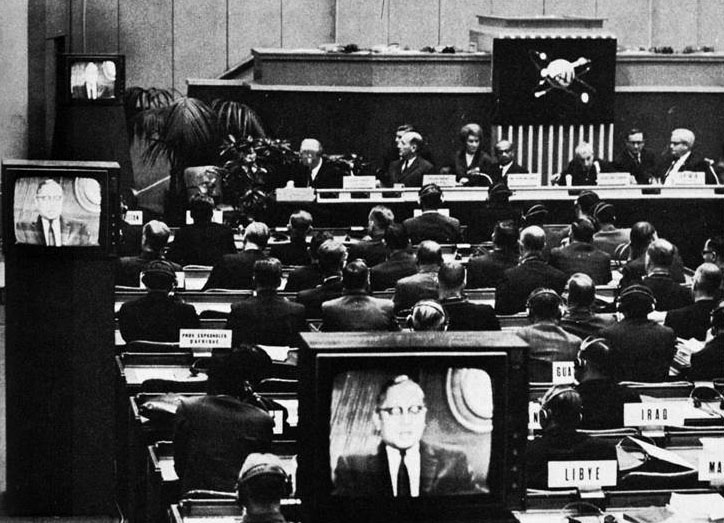 The Telstar-1 communications satellite with the North America Nebula in the background (Source:
NASA)
The Telstar-1 communications satellite with the North America Nebula in the background (Source:
NASA) |
The motion of these satellites had to be tracked as they crossed the sky; a more efficient and economical idea was that of the geostationary communications satellite, first proposed by writer
Arthur C. Clarke in 1945. In 1964, following experiments with geosynchronous satellites, the first geostationary satellite (Syncom-3) was launched.
 United Nations Secretary-General U Thant addressing the ITU's Conference on Space Radiocommunications in Geneva from New York via Telstar (Oct. 7, 1963) (Source: ITU)
United Nations Secretary-General U Thant addressing the ITU's Conference on Space Radiocommunications in Geneva from New York via Telstar (Oct. 7, 1963) (Source: ITU) |
Like radio-frequency spectrum, the geostationary orbit around Earth is a limited natural resource; both need to be shared fairly and in a way that avoids interference. In 1963, ITU held an Extraordinary Administrative Conference for space communications, which allocated frequencies to the various services. Later conferences made further allocations and put in place regulations governing satellites’ use of orbital slots.
 Satellite telephone equipment in use following a disaster Satellite telephone equipment in use following a disaster
(Source: INMARSAT) |
As well as linking broadcasting and wired telephone systems, and providing navigation services, satellites are also used in mobile communications. Satellite phones, for example, can be vital in emergencies, or for areas without access to alternative networks. And in 1992, ITU made spectrum allocations for the first time to serve the needs of Global Mobile Personal Communications by Satellite (GMPCS).
ITU also looks to the needs of radio-astronomers and other space scientists, who conduct such important work as weather prediction and monitoring the Earth’s environment and climate.
Climate change is a major theme of ITU’s work, as are
emergency communications such as satellite-based disaster warning systems.
 WMO Global Observing System (GOS) (Source:
WMO) WMO Global Observing System (GOS) (Source:
WMO) |
